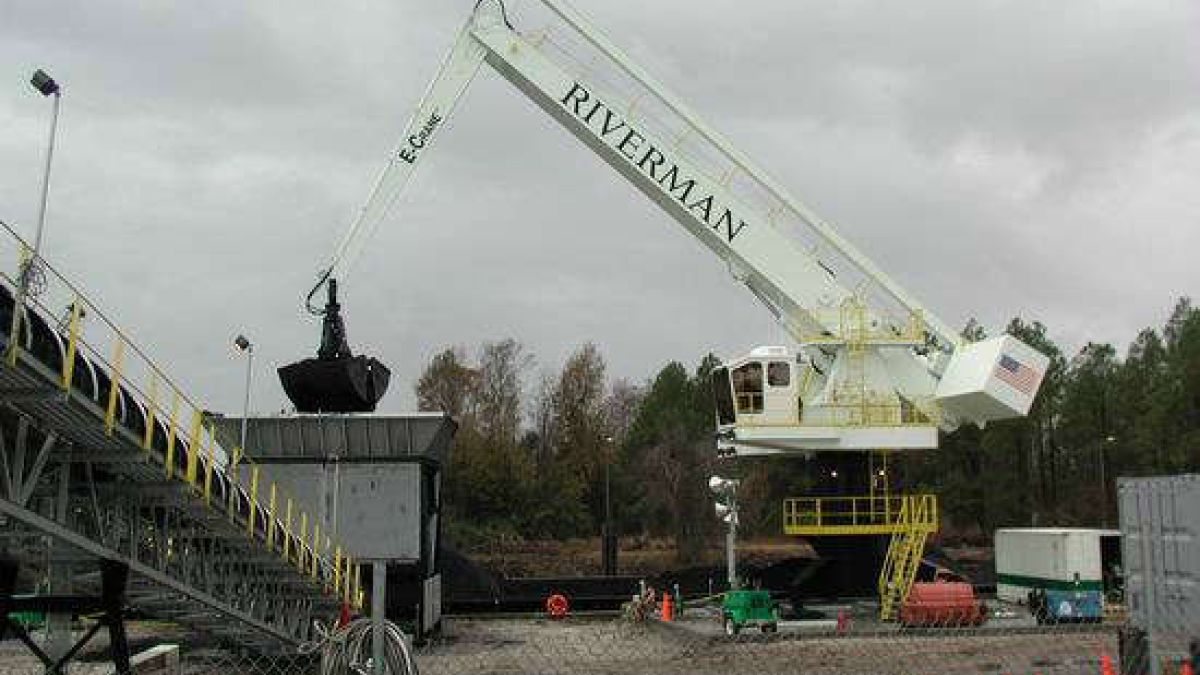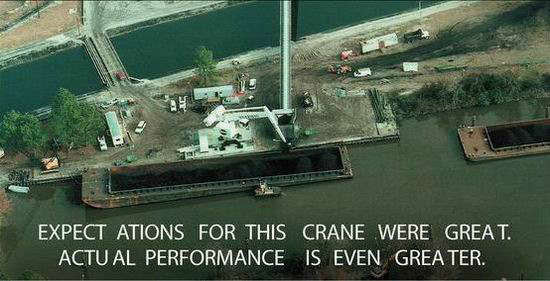
New Barge Unloading Facility for Progress Energy Carolinas Features E-Crane
New Barge Unloading Facility for Progress Energy Carolinas
Features E-Crane®
Photo Captions: Aerial: As the E-Crane at the Progress Energy Sutton Plant offloads coal from barges in the shallow water along the Cape Fear River onto an 855-ft. conveyor system for the final leg of the trip to the plant’s coal yards, it routinely outpaces the takeaway conveyor
Opportunity was waiting for Progress Energy Carolinas’ Sutton Plant in Wilmington, N.C. The plant was fueled exclusively by domestic coal brought in by rail car, and the rapidly increasing cost of U.S. coal and escalating rail freight rates were forcing the utility company to find a more economical coal source. Cheaper, cleaner South American coal was the answer, but the company didn’t have the riverfront property where it could be offloaded.
Enter Atlantic Diving and Marine Contractors, an entrepreneurial marine construction company, also located in Wilmington, which specializes in the construction, repair and maintenance of wharves, piers, bulkheads and other port facilities. The company developed and built a ship receiving facility to handle the job of transloading the coal from the ships to barges, and then transporting it upriver to the plant, efficiently unloading it from the barges and moving it by conveyor from the shoreline to the plant.
The ships bringing the coal in from South America require a minimum water depth of
38 ft., and the Cape Fear River is only about 18-19 ft. deep near the Sutton Plant. So Atlantic Diving outfitted its pier to offload the coal to barges. The barges carry it through the shallower water and deliver it 12 miles upriver to a receiving facility Atlantic Diving constructed on property near the plant. Here, the coal is offloaded to an 855-ft. conveyor system for the final quarter-mile leg of the trip to the coal yards at the power plant.
Offloading Barges the Key to Success
The 3,000-metric-ton barges are about 52’ wide, 14’ deep and 250’ long, making offloading with a traditional hydraulic excavator a highly inefficient solution. The design engineer, Gary Greene of Raleigh, N.C., suggested Atlantic Diving check into the E-Crane®.
The E-Crane Atlantic Diving selected for the Sutton Plant project is a 1000 Series, Model 7248 – relatively small for an E-Crane. But it is equipped with an 8-yd.3 hydraulic clamshell bucket that can reach out horizontally a distance of 81 ft., making it possible to efficiently offload the coal from the barges.
The E-Crane equilibrium crane features a moving counterweight. As the arm extends out, the counterweight extends back. As the arm moves in, the counterweight moves in also. At 75 percent of its maximum reach, the E-Crane with a full payload is in precise balance. Working with the arm either at maximum reach or nearly under the cab, the weight of the entire E-Crane plus half of its payload is balanced. In other words, the E-Crane never has to lift anything heavier than half its payload – 8 yd.3 of coal, in this case. In contrast, conventional excavators and cable cranes have to lift the full payload all the time, plus the weight of the boom and arm, and be counterbalanced for the most extreme anticipated condition.
Compared to conventional cranes that require as much as 80 percent of their available energy just to move the boom, stick and grab, the E-Crane principle results in significantly lower operating and maintenance costs. Because the E-Crane has to do substantially less work, it needs a much smaller (and less costly) motor to move its hydraulics. The E-Crane at the Sutton Plant has a 3-phase, 200-hp electric motor. Compared to a 513-hp diesel motor that would be on a comparably sized conventional excavator, this E-Crane moves about twice the coal with less than half the horsepower.
The E-Crane is exceptionally maneuverable. It can exert a downward force (equal to half the payload) to push the clamshell bucket into the coal, or the operator can exert just enough downward force to clean the coal off the bottom of the barge.
According to Atlantic Diving, the E-Crane is discharging three grabs in 75 seconds into the hopper that feeds the conveyor system. That represents a theoretical digging rate of about 900 tons per hour, which explains why the crane routinely outpaces the takeaway conveyor, which tops out at about 600 tons per hour.
The E-Crane Installation
The E-Crane utilized at the Progress Energy Sutton Plant is mounted on a 4-legged free-standing pedestal. Because Atlantic Diving is in the marine construction industry and has the expertise to build ports and commercial marine facilities, the company chose to build the foundation for the E-Crane itself, so this was a unique installation for the crane supplier, E-Crane International, USA (ECI-USA). E-Crane normally handles the installation from beginning to end, but in this case its role was to provide all the loading information, footprint dimensions and specs to Atlantic Diving, along with other technical support for the construction of the foundation.
The lower portion of the E-Crane is custom built to make sure that the prime digging area is in the sweet spot. According to Danny Hogan, an Atlantic Diving veteran operator with over 20 years of experience, “The E-Crane is perfectly positioned with the crane height optimized to give the operator good visibility into the barge, and ensure that he is working the sweet spot when discharging the hopper.”
Choosing the E-Crane
“Ultimately, we chose the E-Crane for its higher capacity and lower operating cost,”said Andy Tomlin, project manager at Atlantic Diving. “It provides the transfer rate we need with a minimal amount of labor – and it’s made to last. It’s one of the most impressive machines we’ve ever purchased – faster, simpler, and more reliable.”
According to Tomlin, the conveyor belt is running at maximum speed with the hopper chute wide open when the barge shipments arrive, and even with this, the E-Crane can keep the hopper full. The operator fills the hopper and then has time to work cleaning the sides of the barge while it discharges. The E-Crane is even keeping pace with the three shipboard cranes that are being used to transload the coal from the ships to the barges upriver.
“It almost runs itself,” said Hogan. “I’ve run hundreds of pieces of equipment in my day – including lattice boom construction cranes, hydraulic cranes and excavators, rope type clamshells, hydraulic RT cranes, and so on. And I can easily say this E-Crane is the smoothest-running piece of equipment I’ve ever seen.”
“While our experienced operators really appreciate the ease with which the E-Crane handles, what’s been equally beneficial to us is that the machine is extremely easy for inexperienced operators to become proficient with, “ said Tomlin. “ We’ve trained guys that have come in with minimal experience on smaller cranes or backhoes – or even no material handling experience at all – with a very short learning curve. The time it takes them to really catch on to the E-Crane and establish a real comfort level is remarkably shorter than what we have experienced with other heavy material handling equipment.
“The E-Crane is doing everything we expected of it and more,” added Tomlin. “And the folks at E-Crane International were terrific to work with on this project. As with any utility project, there were lots of requirements from Progress Energy in terms of specifications and documentation, and the staff at ECI-USA was extremely responsive in providing all the technical support we needed to meet the customer’s requirements.”
Success Breeds Success
Atlantic Diving has a three-year contract to provide the Progress Energy Sutton Plant with coal, and is currently working together with E-Crane International staff in spec’ing out other future potential waterfront projects.
Progress Energy Carolinas provides electric power and services to 1.3 million customers in North Carolina and South Carolina.
E-Crane International-USA, Bucyrus, Ohio, assisted by North American Equipment, the E-Crane dealer in Nicholasville, KY handled the sale, consulted on the specifications and installed the E-Crane. The E-Crane is manufactured in Adegem, Belgium by NV Indusign.
The picture above: Close-up: Named Riverman, this E-Crane at the Sutton Plant nimbly handles large loads of coal at long outreaches, never having to lift anything heavier than half its 8 yd.3 payload because it features a moving counterweight to keep the crane in balance.
